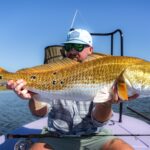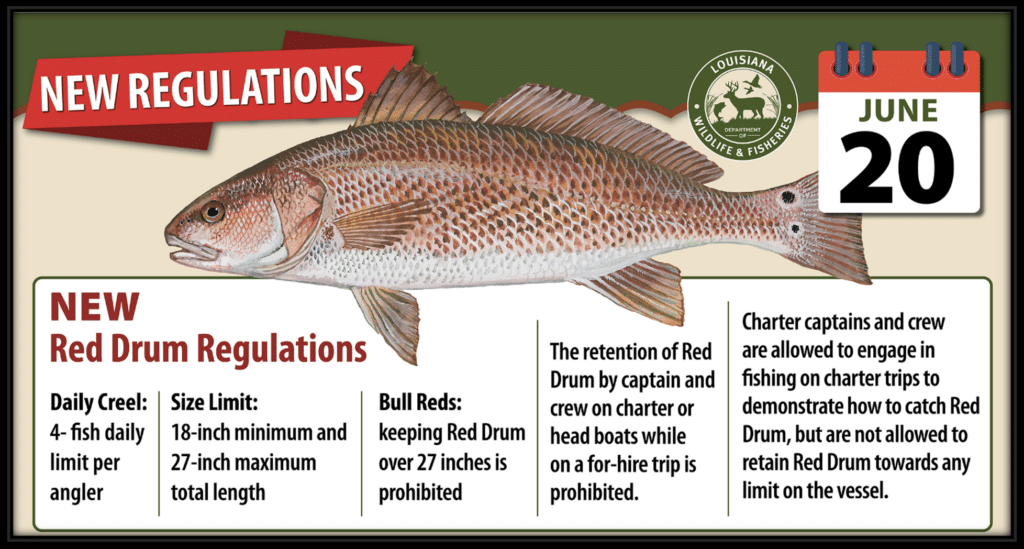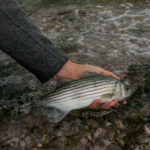
Louisiana Bull Reds Up for Harvest Again: H.B. 604 Must Not Pass
Photo Credit: Carter Abramson | Trevor Johnson Every now and then, we encounter something so
Guest Blog: Mario Campo
Feature Photo: Capt. Ron Ratliff with the bull release. (Costa “Hooked On: Redfish” Film)
Next Thursday, June 20, 2024 marks an important day for Louisiana fisheries as new management for red drum are set to go into effect. The regulations passed by the Louisiana legislature are as follows:
Daily Creel: 4-fish daily, per angler.
Size Limit: 18” – 27” slot
No Bull Red Harvest: Red Drum greater than 27” are prohibited to be kept.
No Guide Limit: Only clients will be able to retain a daily limit. Captains and crew may not retain fish.

How Did We Get Here?
Louisiana first implemented red drum harvest regulations in 1988, establishing a 5-fish daily creel limit with a 16”- 27” slot limit, also permitting the take of 1-fish exceeding 27”. These same regulations remained active and unchanged until this day. The latest red drum stock assessment (2022) depicts dynamic changes in this fishery during this 36-year period. Data suggests overall red drum stock size has drastically varied over the years with a concerning negative trend from 18.3 million fish estimated in 2012 to the lowest estimate in 2021 of 8.7 million fish. Stock size data corroborates observed female spawning stock fecundity data decreasing from an overall high of 78.6 trillion eggs estimated in 2004, to an estimated low of 50.7 trillion eggs in 2021. Concurrently, recreational fishing effort has increased from an estimated 1.4 million trips in 1988 to an estimated average 2.6 million trips from 2011 – 2021. LDWF suggests that low recreational landings are attributed to low annual recruitment of juveniles to the spawning stock. Low recruitment leads to lower spawning potential, which ultimately results in a decrease in overall stock abundance when subjected to sustained fishing effort.
Despite a significant increase in recreational fishing effort, stagnant catch per effort numbers reflect negative trends in stock health. Theoretically, in an abundant fishery, greater fishing effort would yield significantly greater catch per effort. In contrast, if a fishery is in decline while subject to greater fishing effort, results of catch per effort would essentially result in no significant changes due to the limitation of the size of the fishery. For example, a greater number of lines in the water at a higher frequency would not result in a greater number of fish caught if there aren’t more fish to be caught.
Resistance to Change
Upon publication of the 2022 Red Drum stock assessment by LDWF, Louisiana’s red drum fishery became a scalding hot discussion topic. Results of the stock assessment prompted LDWF to seek management propositions initiating a cascade of commission, potpourri, and legislative meetings. Each meeting was filled with passionate public comment from those in support of management action, and those that utterly reject the concept of change. A notable trend was that those in support of conservation out voted those in opposition at every instance of public comment. You can get a full recap of the controversial meeting on March 7 by clicking here.
Common themes for those in opposition claimed that: (1) the science conducted by LDWF biologists was inaccurate, and often included direct insults to persons present in the room representing the department. (2) Those who support conservation-minded management practices were only fly fishermen, lesser skilled, and/or out-of-state anglers. (3) Many in opposition claimed that they see “tons” of red drum. (4) Stock assessment sampling was conducted in wrong areas, and a basin by basins study needs to occur.
Addressing such claims is necessary for a more productive conversation about any newly proposed management practices:
So, What’s Next?
The newly implemented red drum regulations are a step in the right direction for the conservation of an iconic fishery, but they are not the end goal. The new 4-fish, 18 – 27” slot with no guide limit regulations create a 37% reduction in harvest with an approximate 26-year rebuild timeline. For reference, the minimum recommendation by LDWF was a 35% reduction with a 28-year rebuild timeline. We should never accepted “slightly more than the minimum” when attempting to conserve our shared natural resources. Biologically, it is understood that the 30” red drum is considered part of the spawning stock, holding a different role in the fishery compared to the juvenile 16” red drum, which will eventually contribute to escapement value. Therefore, when selecting an appropriate creel/slot limit, numbers alone cannot dictate the decision, also requiring careful biological selection that can garner enough support to pass through the commission and legislature.
A new stock assessment is to be conducted over the coming years to re-evaluate the state of the fishery by 2028. This allows the possibility to assess efficacy of prior implemented regulations and modify them based upon future stock assessment results. The state also has associated fisheries management actions to review and consider, including methods of take like bow fishing. For now, the implementation of new red drum harvest regulations is a win for conservation and all those who have continuously supported the betterment of a precious resource. Not just for red drum, but for all of our marine resources, we must accept dutiful stewardship and aspire for cohesive management practices that work to build a more sustainable future. These regulatory changes are one small step in that marathon.

About The Author: Mario Campo is a graduate research assistance at Southeastern Louisiana University, where he received a B.S. in Biology and currently studies Wetlands Ecology and Restoration as a Masters student. His research focuses on the effects of hydrologic processes on wetlands habitat composition in south Louisiana.
Join The Movement
The fight to protect redfish in Louisiana is ever-changing and will require diligent participation from all stakeholders going forward. Join the American Saltwater Guides Association to stay up to date on the latest science and opportunities to make your voice heard. Advocate Memberships are free, while PRO Memberships provide insider access to new events, gear and contributions to the fisheries funds you care about.

Photo Credit: Carter Abramson | Trevor Johnson Every now and then, we encounter something so

This past weekend, ASGA proudly sponsored the Dirty Carp Tournament in Louisiana — and no, you didn’t misread that.

After years of data pouring in from The Albie Project, advocacy, persistence, and support from

This morning, the Connecticut Environment Committee held a hearing on House Bill 6248, a bill
We rely on our members and donations to keep fighting for a sustainable tomorrow in marine conservation.
GIVE THE GIFT OF FISHERIES CONSERVATION THIS HOLIDAY SEASON. SHOP ASGA GOODS THAT FUND FISHERIES RESEARCH & ADVOCACY CAMPAIGNS
JOIN ASGA IN CALLING FOR CRITICAL MANAGEMENT ACTION AFTER YEARS OF SPAWN FAILURES & POOR MANAGEMENT.
By using this website, you agree to our use of cookies. We use cookies to provide you with a great experience and to help our website run effectively. To learn more, please review our privacy policy.